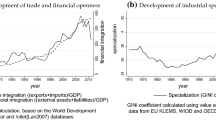Abstract
Statistical indicators used to analyze international specialization are manifold. However, most of them do not measure exactly the intensity of revealed comparative advantages and do not distinguish it from other aspects such as trade performance. This paper surveys the available indicators, discriminating between trade specialization and productive specialization (the gap between domestic supply and demand). It is asserted that in order to describe the international specialization pattern of a country, it is enough to consider the product distribution of the elementary trade balances, normalized with respect to trade (trade specialization) or to internal demand (production specialization). Indeed, while the individual, normalized trade balances are only performance indicators, deviations from their average correctly measure the intensity of specialization.
Similar content being viewed by others
References
Amiti, M. "Specialization Patterns in Europe,"Weltwirtschaftliches Archiv, 135, 4, 1999, pp. 573–93.
Balassa, B. "Trade Liberalization and ‘Revealed’ Comparative Advantage,"The Manchester School of Economic and Social Studies, 33, 2, 1965, pp. 99–123.
__. "Tariff Reductions and Trade in Manufacturing Among the Industrial Countries,"American Economic Review, 56, 1966, pp. 466–73.
Baldwin, R. E., ed.Trade Policy Issues and Empirical Analysis, Chicago, IL: University of Chicago Press, 1988.
Bowen, H. P. "On the Theoretical Interpretation of Indices of Trade Intensity and Revealed Comparative Advantage,"Weltwirtschaftliches Archiv, 119, 3, 1983, pp. 464–72.
Centre d'Etudes Prospectives et d'Informations Internationales.Economie Mondiale: La Montée des Tensions, Paris, France: CEPII, 1983.
Dagenais, M. G.; Muet, P. A., eds.International Trade Modeling, London, United Kingdom: Chapman and Hall, 1992.
Dalum, B.; Laursen, K.; Villumsen, G. "Structural Change in OECD Export Specialization Patterns: Despecialization and ‘Stickiness’,"International Review of Applied Economics, 12, 3, 1998, pp. 423–43.
Feenstra, R. C., ed.Empirical Methods for International Trade, Cambridge, MA: MIT Press, 1988.
Greenaway, D.; Hine, R.; Milner, C. "Country-Specific Factors and the Pattern of Horizontal and Vertical Intraindustry Trade in the United Kingdom,"Weltwirtschaftliches Archiv, 130, 1, 1994, pp. 77–100.
Greenaway, D.; Torstensson, J. "Back to the Future: Taking Stock of Intraindustry Trade,"Weltwirtschaftliches Archiv, 133, 2, 1997, pp. 249–69.
Greenaway, D.; Winters, L. A., eds.Surveys in International Trade, Oxford, United Kingdom: Blackwell, 1994.
Grubel, H. G.; Lloyd, P. J. "The Empirical Measurement of Intraindustry Trade,"The Economic Record, 47, 1971, pp. 494–517.
__.Intraindustry Trade: The Theory and Measurement of International Trade in Differentiated Products, London, United Kingdom: Macmillan, 1975.
Hooper, P.; Richardson, J. D., eds.International Economic Transactions: Issues in Measurement and Empirical Research, Chicago, IL: University of Chicago Press, 1991.
Iapadre, L. "Structural Factors and Competitiveness in International Trade: A Reformulation of the Constant Market Shares Analysis Method," proceedings from Recent Developments in International Economics, June 1995.
Jungmittag, A.; Grupp, A.; Hullmann, A. "Changing Patterns of Specialization in Global High-Technology Markets: An Empirical Investigation of Advanced Countries,"Quarterly Journal of Economic Research, 2, 1998, pp. 86–98.
Kol, J.; Mennes, L. B. M. "Corrections for Trade Imbalance: A Survey,"Weltwirtschaftliches Archiv, 125, 4, 1989, pp. 703–17.
Lafay, J. "The Measurement of Revealed Comparative Advantages," in M. G. Dagenais; P. A. Muet, eds.,International Trade Modeling, London, United Kingdom: Chapman and Hall, 1992, pp. 209–34.
Lafay, J.; Herzog, C.Commerce International: La Fin des Avantages Acquis, Paris, France: Centre d'Etudes Prospectives et d'Informations Internationales, 1989.
Leamer, E. E.; Levinsohn, J. "International Trade Theory: The Evidence," in G. M. Grossman; K. Rogoff, eds.Handbook of International Economics, 3, Amsterdam, Netherlands: Elsevier, 1995, pp. 1339–94.
Leamer, E. E.; Stern R. M.Quantitative International Economics, Chicago, IL: Aldine, 1970.
Vona S. "Intraindustry Trade: A Statistical Artifact or a Real Phenomenon?,"Banco Nazionale del Lavoro Quarterly Review, 43, 175, 1990, pp. 383–412.
__. "On the Measurement of Intraindustry Trade: Some Further Thoughts,"Weltwirtschaftliches Archiv, 127, 4, 1991, pp. 678–700.
Author information
Authors and Affiliations
Rights and permissions
About this article
Cite this article
Iapadre, P.L. Measuring international specialization. International Advances in Economic Research 7, 173–183 (2001). https://doi.org/10.1007/BF02296007
Issue Date:
DOI: https://doi.org/10.1007/BF02296007




